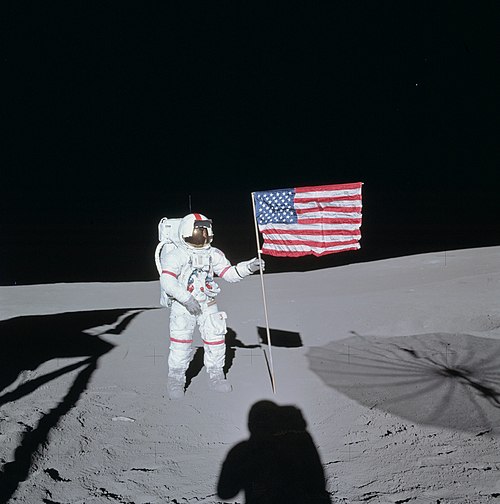Facts for Kids
Apollo 14 was a pivotal mission in the Apollo program, highlighting lunar exploration with significant scientific research and historic milestones.
Overview
Lunar Landing
Facts And Trivia
Launch And Flight
Legacy And Impact
Astronaut Profiles
Mission Objectives
Scientific Experiments
Challenges And Solutions

Inside this Article
Kennedy Space Center
Space Exploration
Wright Brothers
Alan Shepard
Information
Astronaut
Triumph
Apollo
Space
Did you know?
🌕 Apollo 14 was the eighth crewed mission in NASA's Apollo program.
🚀 It launched on January 31, 1971, from Kennedy Space Center.
👨🚀 The mission was commanded by Alan Shepard, the first American in space.
🌌 Apollo 14's lunar module was named Antares, after a red supergiant star.
🔍 The mission aimed to explore the Fra Mauro highlands of the Moon.
🏆 Apollo 14 brought back 42.3 kilograms (93.7 pounds) of lunar samples.
⚙️ Alan Shepard famously hit two golf balls on the lunar surface during the mission.
📅 The mission lasted a total of 9 days, 2 hours, and 53 minutes.
🔄 Apollo 14 successfully conducted the first use of the Modular Equipment Transporter (MET) for lunar exploration.
🛰 The command module, named Kitty Hawk, orbited the Moon while the lunar module descended.
Introduction
Lunar Landing
The Lunar Module, called "Antares," touched down smoothly, and the astronauts were excited! Alan Shepard was the first to exit the Lunar Module and walk on the Moon’s surface for just over 8 hours! He drove a special vehicle called the Lunar Roving Vehicle (LRV) 🛺 and even hit golf balls on the Moon. Edgar Mitchell also explored the area and collected a total of 100 pounds of moon rocks and soil to bring back to Earth! This landing helped scientists learn more about the Moon's composition. 🌌
Facts And Trivia
Apollo 14 was the first mission to use a special equipment called the "Lunar Roving Vehicle" (LRV), allowing the astronauts to drive on the Moon! Alan Shepard hit two golf balls on the lunar surface, making him the first person to play golf on the Moon! 🏌
️♂️ Apollo 14 brought back 100 pounds (45 kilograms) of lunar rock samples! 🌑
In total, there have been six successful Apollo missions that landed on the Moon. The lunar module of Apollo 14 was named "Antares," honoring a bright star. 🌌
Launch And Flight
️ During the journey, the astronauts conducted checks and prepared for landing. They enjoyed breathtaking views of Earth and the Moon from their spacecraft. After traveling for about three days, they were ready to attempt landing! They had to carefully plan their descent to ensure a safe arrival. ✨
Legacy And Impact
It was a key mission that helped scientists better understand the Moon’s surface and geology. The samples collected by the astronauts are still studied today, helping us learn even more! The success of Apollo 14 also boosted public interest in space exploration and inspired future missions. It showed that humans could travel to the Moon, conduct experiments, and safely return to Earth! 🌍
The mission also laid the groundwork for future Apollo missions, such as Apollo 15, that explored other areas and took even better equipment to the Moon! 🛰
️
Astronaut Profiles
🚀
Mission Objectives
They wanted to investigate the Moon's geology and learn more about its history. The astronauts also set up scientific experiments, such as measuring the Moon's gravitational pull. They aimed to explore the highlands of the Moon, especially the area called the Fra Mauro region. This location had been chosen because it was believed to have interesting rocks! 🪨
The astronauts wanted to gather valuable information that could help scientists understand how the Moon formed billions of years ago. 🌌
Scientific Experiments
They also placed a retroreflector, which is a special mirror that reflects light back to the source. Scientists on Earth still use this for experiments today! 🌟
The astronauts spent about 33 hours outside the Lunar Module doing experiments, taking pictures, and collecting samples. They even had time to enjoy the view! These experiments provided important data that helped improve our understanding of the Moon and space! 📡
Challenges And Solutions
One challenge was making sure the Lunar Module landed safely. During the descent, the astronauts had to quickly adjust their landing approach to avoid rocky areas. They worked together to solve this problem by carefully following instructions and making quick decisions! Also, weather conditions at the launch site were not perfect, but mission control decided to go ahead with the launch, and it was a success! The teamwork and clever solutions from the astronauts, engineers, and scientists helped overcome obstacles and made Apollo 14 a remarkable triumph! 🎉

